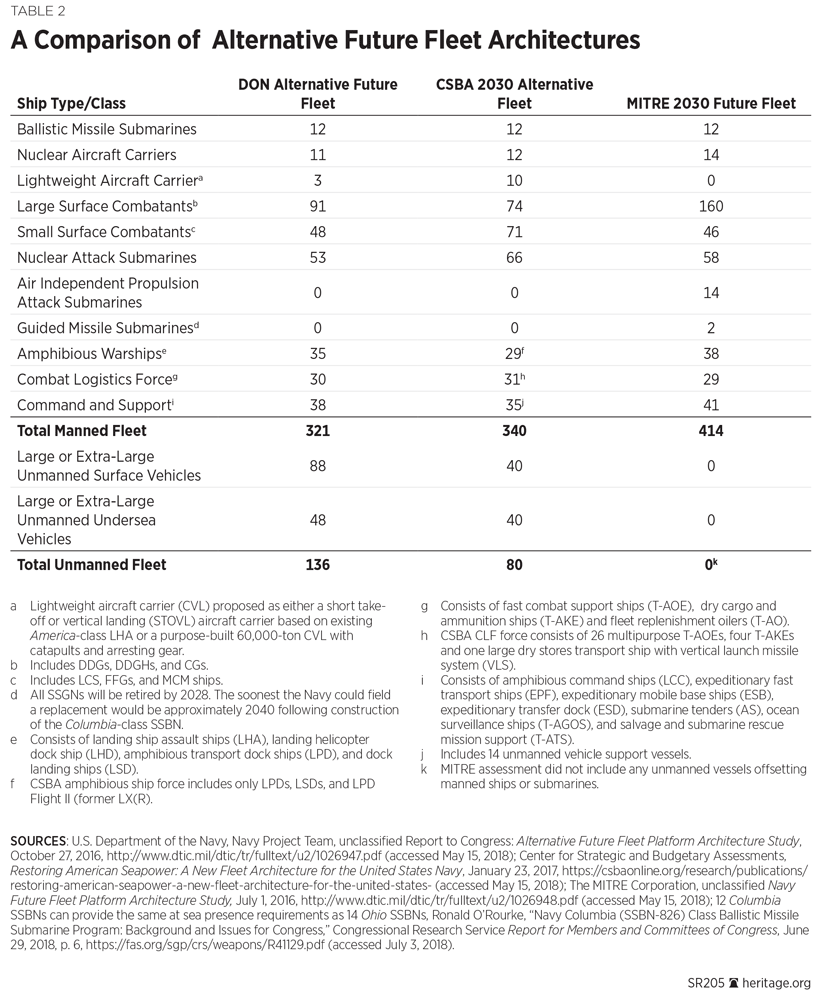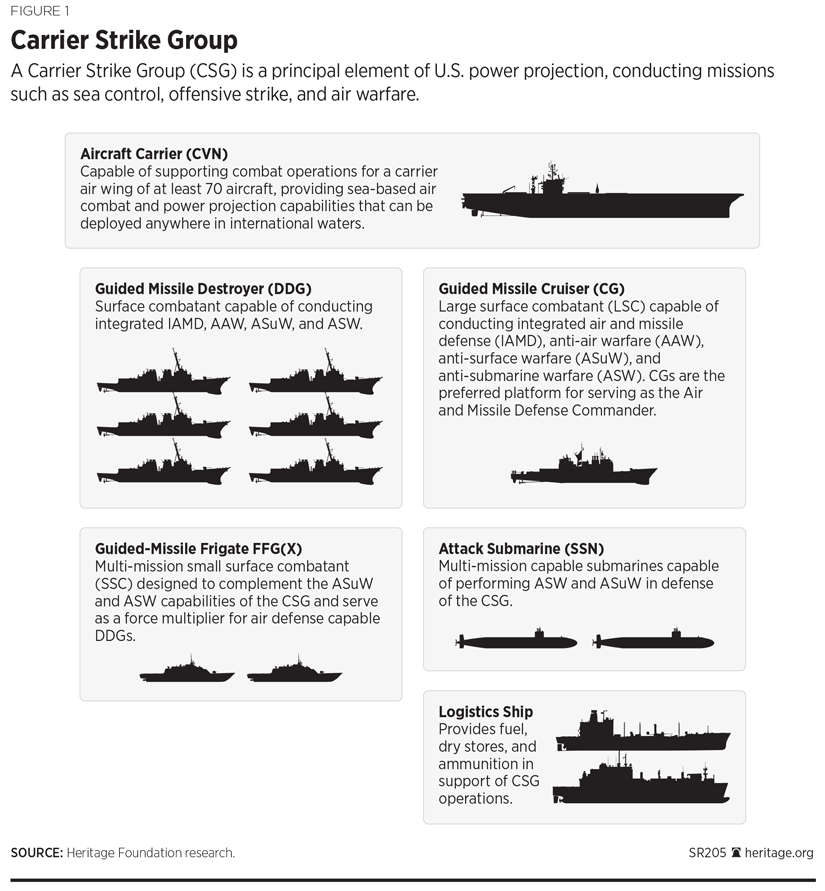Introduction
Since its inception, the United States has been a maritime nation whose economy and security depend on the oceans. It was threats to American merchant shipping by the Barbary pirates that led Congress to authorize the fledgling U.S. Navy’s first six frigates. Maritime trade, first with Europe and later with the world, has fueled our economy since colonial times. Today, “[n]early 80 percent of U.S. export trade by tonnage moves over water.”REF
In addition, the Atlantic and Pacific Oceans have provided our nation with natural boundaries spanning thousands of miles to help keep our adversaries at bay. Since World War II, the U.S. Navy has continuously maintained a portion of the fleet deployed globally in regions that are vital to the nation’s security. This allows the nation’s senior leadership and the Navy to respond rapidly to regional crises and, if necessary, engage aggressors in the open ocean or near their own coasts, keeping the fight and threat far from U.S. shores.
Unlike ground or air forces, which require fixed, large support bases necessitating host nation consent, the U.S. Navy can operate freely at sea across the globe and shift its presence wherever needed without any other nation’s permission. It can do this because the vast majority of the 139 million square miles of the world’s oceans are international waters and not subject to any one nation’s laws or control.REF
A U.S. Navy strike group consisting of warships supported by logistics ships can operate continuously at sea for several months without needing to enter port. In other words, access to local ports for the resupply of logistic ships is desired but not required. As a result, the Navy is often America’s first responder to regional crises and, with its persistent forward presence, preserves U.S. security interests through the spectrum of military operations. In addition to the ability to project combat power rapidly anywhere in the world, a globally deployed peacetime Navy supports such missions as securing sea lines of communication (SLOC) for the free flow of goods and services and freedom of navigation operations to contest unlawful maritime territorial claims.
This paper provides the recommended minimum numbers of battle force ships required to handle two simultaneous or nearly simultaneous major regional conflicts (MRCs) with a 20 percent additional margin. Although U.S. defense strategies have varied over the past 25 years, the need for America to conduct two nearly simultaneous major combat operations has been a consistent theme.REFAs summarized succinctly by Daniel Gouré:
Senior decision makers across five Administrations, Republican and Democrat, have been unable to avoid the reality that, in a world of continuing globalization and growing political and military uncertainty, the U.S. needs a military that is large enough and has sufficient range of capabilities to cover multiple major military contingencies on overlapping time frames.REF
The extra 20 percent capacity both serves as a strategic reserve and helps the U.S. to maintain an enduring peacetime global forward naval presence. A strategic reserve is necessary because training and maintenance requirements make it infeasible to deploy 100 percent of the force, and committing the entire force to combat operations would leave the nation without any resources to handle unexpected crises.REF In addition, some ship and submarine losses should be expected in an MRC against a near-peer competitor. A strategic reserve is therefore needed to replace damaged or sunk ships, because the time needed to repair (one year) or build (five years) modern ships makes it highly unlikely that they could be returned to the fight before a conflict has ended.
This independent analysis reviewed previous U.S. naval force structure assessments, historical naval combat operations, U.S. Navy and Marine Corps guidance on naval force composition, current and near-future maritime threats, U.S. naval strategic guidance, and enduring naval missions. Unmanned systems or ship classes that are not current programs of record were not included in this assessment. While unmanned systems offer the promise of improved effectiveness and operational reach for ships and submarines, they are not yet mature enough to replace a manned ship or submarine in the battle force, and their capabilities have not been demonstrated to the point that they allow for an assessment of their potential to substitute for a manned vessel.
This paper will establish that the U.S. Navy needs a minimum of 400 battle force ships to:
- Effectively provide the 13 carrier strike groups (CSGs) and 12 expeditionary strike groups (ESGs) required to meet the two-MRC construct;
- Provide the historical steady-state demand of approximately 100 ships constantly forward deployed in key regions around the world; and
- Have sufficient capacity to maintain its ships properly and ensure that its sailors are adequately trained to “fight tonight.”
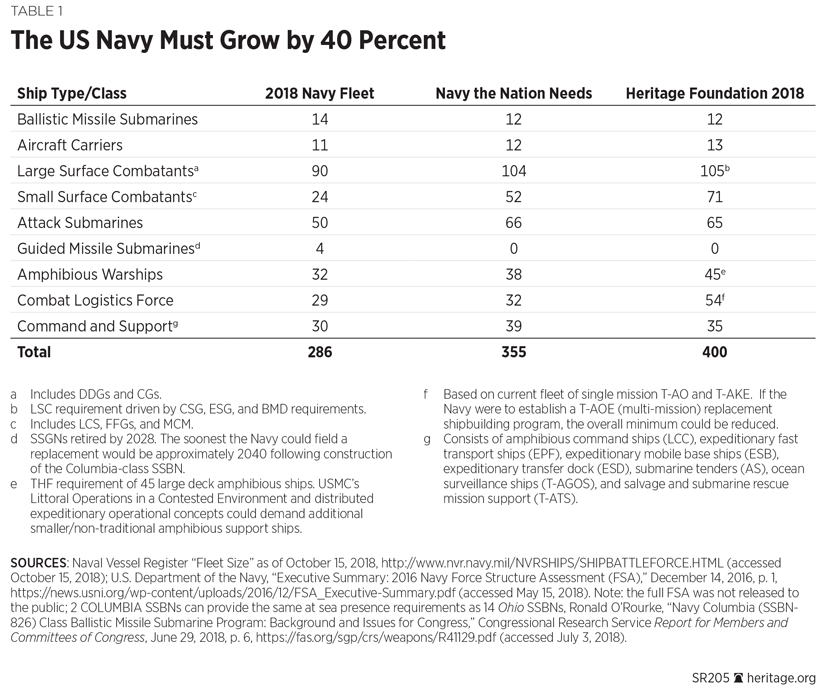
This represents a significant increase from the U.S. fleet’s 286 battle force ships as of October 2018,REF the 2015 Heritage Foundation benchmark of 346 ships,REF and the official U.S. policy of “not fewer than 355 battle force ships” as established in the fiscal year (FY) 2018 National Defense Authorization Act (NDAA).REF However, it is fully in accord with previous strategic competition assessments, over 70 years of historical naval records, and Navy analysis concluding that a fleet of at least 459 ships was “needed to achieve Navy’s missions with reasonable expectations of success without incurring significant losses.”REF
The U.S. Navy maintained more than 400 ships throughout the Cold War, the last time its force structure was designed to address a strategic competition adversary,REF but recent fleet readiness issues and emphasis on the “reemergence of long-term strategic competition” in the 2018 National Defense Strategy (NDS)REF point to the need for a much larger and more capable fleet. This larger fleet includes not only additional small surface combatants (SSCs) to support the strike groups, but also a significant increase in combat logistics force (CLF) ships to ensure that distributed forces deployed in peacetime and combat operations can receive timely fuel, food, and ammunition resupply. It also requires, on average, four ships in the fleet to maintain one ship forward deployed. More important, the fleet must have the capacity to provide the required CSGs and ESGs when called upon to do so during MRC operations.
Although a 400-ship fleet may be difficult to achieve based on current and projected levels of Department of Defense (DOD) funding and the present shipbuilding industrial base capacity, this benchmark is based strictly on assessed force sizing requirements. The U.S. Constitution grants Congress the power “to provide for the common Defence” and “to provide and maintain a Navy.”REF It is therefore incumbent on Congress and the DOD to prioritize and provide stable funding for a long-term shipbuilding plan to achieve this requirement. Otherwise, the ability of the United States to deter aggression and win in conflict when necessary will be at risk.
The fatal collisions of 2017 demonstrated how years of fiscal pressure could stretch a Navy that is too small for the demands the nation places on it to its breaking point. While the increased funding and priority placed on Navy readiness have helped to turn the tide, unless the fleet becomes significantly larger, the Navy will be unable to meet its operational demands and ensure that the fleet is ready to respond rapidly to crises. Potential adversaries are building larger and more capable navies and proliferating weapons systems that significantly increase the threat to the nation and our maritime allies with each passing year.
Force Requirement Drivers
A few key documents inform the Navy’s day-to-day fleet requirements:
- The 2017 National Security Strategy of the United States of America;REF
- The 2018 National Defense Strategy;REF
- The Global Force Management Allocation Plan (GFMAP);REF and
- The 2016 Design for Maintaining Maritime Superiority, Version 1.0.REF
The 2017 National Security Strategy states that:
The size of our force matters. To deter conflict and, if deterrence fails, to win in war, the Nation must be able to field forces capable of operating in sufficient scale and for ample duration to defeat enemies, consolidate military gains, and achieve sustainable outcomes that protect the American people and our vital interests.REF
The 2018 National Defense Strategy, issued by Secretary of Defense James Mattis, describes 11 DOD objectives for the Navy and the U.S. military’s other branches. Among these 11 goals are “defending the homeland from attack; sustaining Joint Force military advantages, both globally and in key regions; deterring adversaries from aggression against our vital interests; and ensuring common domains remain open and free.”REF The NDS also directs that a more lethal, resilient, and agile force be built to deter and defeat aggression by great-power competitors and adversaries in all warfare domains and across the spectrum of military operations.REF
In addition, the U.S. Navy must meet forward presence requirements laid out in the FY 2018 GFMAP, which states the force presence needed around the world as determined by the Combatant Commanders (CCDRs) and the Secretary of Defense. To meet the objectives of the NDS and GFMAP, the Navy and Marine Corps must maintain two carrier strike groups and two amphibious ready groups (ARGs) forward deployed at all times and three additional CSGs and ARGs trained and ready to deploy within 30 days.REF Navy leadership has stated that it cannot meet this requirement with its existing fleet force structure.REF
The DOD, through the Joint Staff and the CCDRs, manages a select set of real-world operational plans (OPLANS) focused on specific situations where the U.S. feels it is most likely to conduct military operations up to and including war. OPLANS direct not only the size and capabilities of the military forces required to defeat the enemy, but also which specific units will deploy; how these forces will move into the theater (the sequencing of units); which ports and airfields will be utilized; how much ammunition, fuel, and other supplies are required at the beginning of operations; how much transportation or “lift” is needed to get the force there (by air, sea, trucks, or rail); and the basic plan of attack. These analyses and planning scenarios inform service efforts to develop, equip, train, and field military forces that can successfully defend national security interests.REF Since these OPLANS are classified national security information, this paper does not address them.
Fleet size can be a misleading statistic, with several factors contributing to the required number of ships. One of the primary drivers of total fleet size is the number of ships constantly forward deployed to meet the demands of operational commanders. On average, over the past 25 years, the Navy has maintained approximately 85–100 ships continuously deployed even as the total fleet size has decreased from approximately 450 shipsREF to today’s fleet of 286 battle force ships.REF As of July 2018, the U.S. Navy had 89 ships globally deployed including 47 in the Western Pacific Ocean; 27 in the North Atlantic Ocean, Baltic Sea, and Mediterranean Sea; and 14 in the Persian Gulf, Red Sea, and Arabian Sea.REF
As the total fleet size has decreased, the ratio of ships deployed compared to total fleet size has increased from a sustainable four-to-one ratio to today’s three-to-one ratio. Recent events and congressional testimony by senior Navy leaders have demonstrated that maintaining approximately one-third of the fleet constantly deployed has placed excessive stress on the U.S. fleet’s ships and sailors and that the negative consequences for fleet readiness and proficiency have been significant. In addition to military operations and exercises in support of CCDRs, maintaining a sufficient number of ships persistently deployed to key regions of the world is critical to deterring state and non-state actors from aggressive actions against fellow maritime nations or threatening the free and peaceful use of the global maritime commons for all nations.
The Navy also must be able to defend the United States and its allies when called upon with the benchmark of being capable of handling two simultaneous or nearly simultaneous MRCs. The Department of Defense articulated this need in its 2012 Defense Strategic Guidance: “As a nation with important interests in multiple regions, our forces must be capable of deterring and defeating aggression by an opportunistic adversary in one region even when our forces are committed to a large-scale operation elsewhere.”REF Given recent world events and the 2018 NDS’s focus on the reemergence of long-term strategic competition with China and Russia as well as on deterring and countering rogue regimes like North Korea and Iran, the need for the U.S. military to have the capability and capacity to fight and win two overlapping MRCs is only growing.REF
A Navy that is large enough to fight and win two nearly simultaneous MRCs also supports a forward global naval presence that provides a greater deterrence to conflict. As Secretary Mattis states in his 2018 NDS, “The surest way to prevent war is to be prepared to fight one.”REF While building and maintaining such a Navy is expensive, history has repeatedly shown that the cost of war is significantly greater, both in terms of lives lost and in terms of money spent. When quantifying naval combat power through this lens, the defining metric is not necessarily total ship count, but rather the number of CSGs, ESGs, submarines, and other naval groups essential not only to winning the war in the maritime domain, but also to ensuring that the Joint Force is victorious in the broader war effort across all domains.
The U.S. Navy measures capacity by the number of ships rather than the number of sailors, and not all ships count equally. The type or class of ship is also important. For example, the capabilities and contribution to combat operations of an aircraft carrier and its associated air wing are significantly greater than those of a littoral combat ship (LCS). The Navy focuses mainly on the size of its “battle force” and defines battle force ships as “commissioned United States Ship (USS) warships capable of contributing to combat operations, or a United States Naval Ship (USNS) that contributes directly to Navy warfighting or support missions.”REF Auxiliary support ships such as hospital ships and cable repair ships, combatant craft such as patrol coastal vessels and landing craft, and support craft such as tugs and dry docks are not classified as battle force ships.
Operational commanders require the proper mix of capabilities and ship types deployed to enable a timely and effective response to emergent crises. Depending on the mission, this means a combination of aircraft carriers; guided missile destroyers (DDGs); attack submarines (SSNs); amphibious warships; combat logistics ships; and/or other vessels. The Navy normally can maintain only a portion of the battle force fleet at sea at the same time. Most of the fleet is based in the continental U.S. (CONUS) to undergo routine maintenance and training, as well as to limit deployment time for sailors to sustainable levels. However, given the CCDRs’ requirements for naval power presence in their respective regions, there is an impetus to have as many ships forward deployed as possible.
The vast distances across the world’s oceans and the relatively slow average transit speeds of naval warships (14 to 16 knots)REF also necessitate that the U.S. Navy maintain sufficient numbers of ships constantly forward deployed in key regions around the world. This enables the Navy to respond quickly to a crisis, deter potential aggression, and assure our allies and maritime partners that the nation remains committed to and capable of defending its national security interests and alliances. Considering that it takes a minimum of 22 days for a Norfolk-based CSG to reach the Persian Gulf and a minimum of 18 days for a San Diego-based CSG to transit to the South China Sea, the reason for maintaining these naval forces forward deployed to these critical regions becomes clear.REF Potential adversaries choose when and where they will take aggressive actions, and if our naval forces cannot respond for three weeks, the conflict might well already be lost. At the very least, it would be much more difficult to win than it would have been if our battle force ships were able to respond swiftly within hours or days and potentially deter hostile military action from occurring.
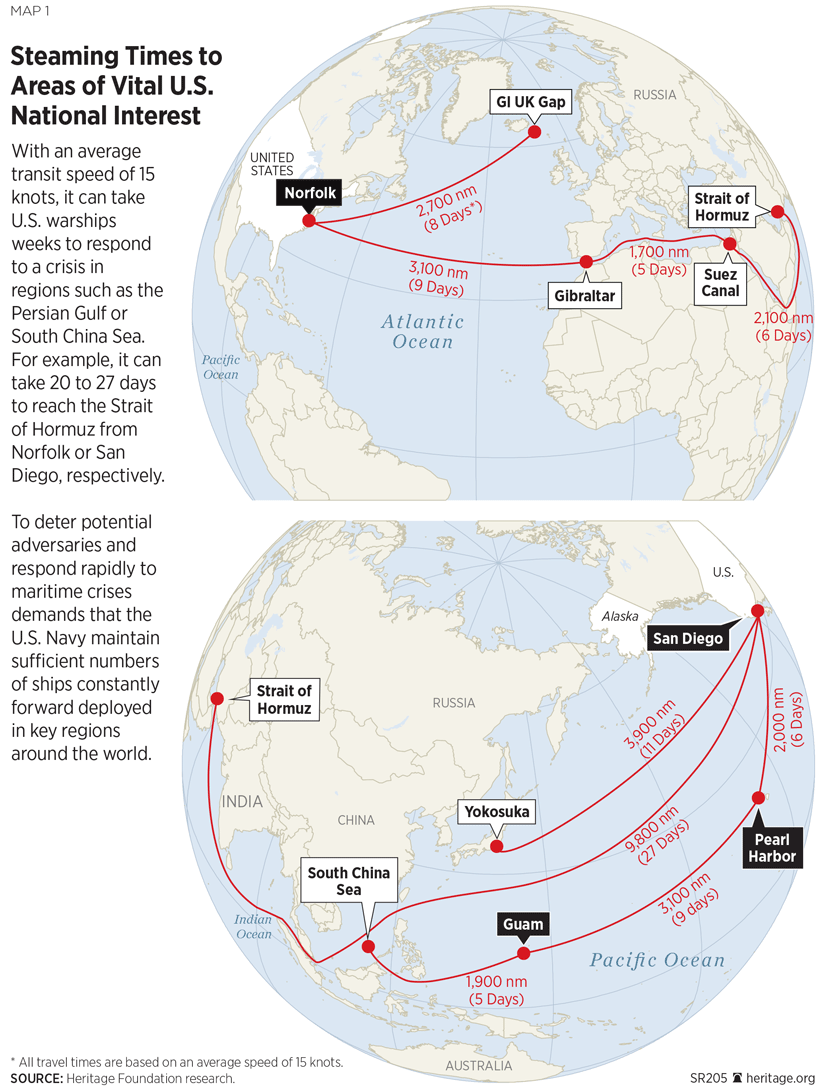
While 47 ships in the Western Pacific Ocean may seem like a large number, a closer examination reveals how thinly stretched the U.S. Navy’s Pacific Fleet has become. First, the Chinese People’s Liberation Army Navy alone has approximately 150 naval combatant ships ranging from frigates to large-deck amphibious ships and an aircraft carrier.REF If smaller combatants such as mine warfare ships and coastal missile patrol craft are included, the number becomes approximately 450 ships,REF which is almost 10 times the size of the U.S. Seventh Fleet. When the Russian Pacific Fleet and the North Korean navy are added, the regional naval capacity mismatch only increases. Admittedly, it is unlikely that the U.S. Navy would be involved in simultaneous conflicts against these three naval forces, but to deter all three nations effectively, it must provide a credible regional naval capacity. Although the capabilities of an Arleigh Burke-class guided missile destroyer are vastly superior to those of a Chinese coastal missile patrol craft, an overwhelming quantity advantage can help to mitigate this disparity. In addition, a single ship can be in only one location at a time.
The vast size of the Pacific Ocean presents its own challenges for naval forces. Covering “more than 60 million square miles” or “30 percent of the Earth’s surface,” the Pacific Ocean is “larger than the landmass of all the continents combined.”REF Since the U.S. Pacific Fleet consists of approximately 200 ships,REF this equates to one ship for every 300,000 square miles. Even though the specific regions of the Pacific Ocean that are vital to the Navy and U.S. national interests are a fraction of this total area, ships must still transit thousands of miles from their bases to reach these critical locations or even to respond to crises within the region.
In December 2016, the U.S. Navy released its most recent study of forecasted fleet requirements. The Navy Force Structure Assessment (FSA) was developed to “determine the right balance of existing forces…needed to address the ever-evolving and increasingly complex maritime security threats the Navy is required to counter in the global maritime commons.”REF The Navy concluded that a 653-ship force would be necessary to address all of the demands registered in the FY 2017 Global Force Management (GFM) system. A fleet of 459 ships—200 fewer than the ideal fleet but thought still to be too expensive given current and projected limits on defense spending—would meet warfighting requirements but accept risk in providing continual-presence missions.REF The Navy’s final force objective of 355 ships is based on a minimum force structure that “complies with defense planning guidance,” “meets approved Day 0 and warfighting response timelines,” and “delivers future steady state and warfighting requirements…with an acceptable degree of risk (e.g. – does not jeopardize joint force campaign success).”REF
The 355-ship battle force is an increase of 47 ships from the previous Navy requirement of 308 ships. The most significant increases are:
- Aircraft carriers, from 11 to 12;REF
- Large surface combatants (LSCs), comprised of DDGs and guided missile cruisers (CGs), from 88 to 104 to “deliver increased air defense and expeditionary BMD [ballistic missile defense] capacity and provide escorts for the additional Aircraft Carrier”;REF
- Attack submarines (SSNs), from 48 to 66 to “provide the global presence required to support national tasking and prompt warfighting response”;REF and
- Amphibious ships, from 34 to 38.REF
Section 1025 of the FY 2018 National Defense Authorization Act states in part: “It shall be the policy of the United States to have available, as soon as practicable, not fewer than 355 battle force ships, comprised of the optimal mix of platforms, with funding subject to the availability of appropriations or other funds.”REF Having a minimum U.S. Navy fleet size codified in law could place pressure on current and future Administrations to build and maintain such a fleet and make it harder for future Administrations to reduce the recommended number of battle force ships.
In addition, Section 1067 of the FY 2016 NDAA required that “three independent studies of alternative future fleet platform architectures for the Navy in the 2030 timeframe” be completed in 2016.REF The Department of the Navy, Center for Strategic and Budgetary Assessments (CSBA), and MITRE Corporation were tasked with addressing “Alternative roles and missions for United States naval forces”; “The role of evolving technology on future naval forces, including unmanned systems”; and “Opportunities for reduced operation and sustainment costs.”REF Their analyses included several new ship and submarine classes that are not currently in development by the U.S. Navy, such as a lightweight aircraft carrier (CVL) and helicopter destroyer (DDGH), as well as the extensive use of undersea, surface, and air unmanned systems to take on some of the missions and tasking of manned platforms.REF Specifically:
- The Navy Department recommended a fleet of 321 manned ships coupled with 136 large unmanned undersea vehicles (UUVs) and large unmanned surface vehicles (USVs);REF
- The CSBA’s 2030 alternative fleet included 340 manned battle force ships as well as a combined 80 extra-large USVs and extra-large UUVs,REF and MITRE’s analysis proposed a fleet of 414 manned ships.REF
Navy Force Structure Methodology
The Heritage Foundation’s Index of U.S. Military Strength has established a benchmark against which to measure America’s military forces:
[T]he service’s size (be it end strength or number of platforms) is compared to the force size required to meet a simultaneous or nearly simultaneous two-war or two–major regional contingency (MRC) benchmark. This benchmark consists of the force needed to fight and win two MRCs and a 20 percent margin that serves as a strategic reserve.REF
A strategic reserve is necessary because deployment of 100 percent of the fleet at any one time is extremely improbable and risky. Enduring requirements like training and maintenance make simultaneously deploying the entire fleet infeasible, and committing 100 percent of the battle force would leave the nation without any resources available to handle emergent crises.
Several Navy-specific metrics regarding fleet readiness and deployment cycles support a minimum capacity margin of at least 20 percent above fleet operational requirements. First, the Navy’s Optimized Fleet Response Plan (OFRP) dictates a 36-month cycle of maintenance, training, and forward deployment.REF Specifically, it “allows for six months of shipyard maintenance, eight months of basic and integrated training, and then 22 months for a seven-month deployment followed by sustainment, in which the applicable ship will be at its homeport but maintaining a deployed-force level of proficiency.”REF Assuming that a nuclear aircraft carrier (CVN) and its escort ships are not available for a surge deployment until their six-month maintenance cycle and a 30-day minimal training period are complete, this equates to at least a 19 percent unavailability in the 36-month cycle.
The seven-month deployment per each OFRP cycle also equates to five CVNs required for a 1.0 continuous forward-deployed CVN presence. Later in the life cycle of a ship class, a portion of these ships will be continuously undergoing a major depot modernization and maintenance period of from one to four years depending on the type of ship. During this depot modernization, these ships will be unavailable for any operational tasking. For example, six of the Navy’s 22 Ticonderoga-class guided missile cruisers are currently in various stages of a two-phase modernization program.REF
“Presence” is “the number of days a ship spends in an area of operations—excluding depot maintenance periods—divided by 365.”REF A 1.0 ship presence means that there is an operational ship of the type required (CVN, DDG, etc.) present 365 days a year in the area of operations. Conversely, a 0.5 ship presence means that there is one operational ship present in the desired area of operations for only 180 days a year. Since presence depends on whether the ship is in the geographic area of interest and forward-deployed naval forces (FDNF) homeported overseas are always physically in their assigned area of operations, their presence is significantly greater than that of CONUS-based ships.
“Operational Availability” is “the number of days a ship is available for operational tasking in a year.”REF A ship “can be considered operationally available even if it is in maintenance, if it is able to get underway and execute a mission in a short period of time.”REF (It should be noted that the definitions of “presence” and “operational availability” do not account for the time needed for training and certification for forward-deployed ships.)
“Deployed underway time” is “the number of days a ship spends away from port, referred to as underway days, deployed in the 4th, 5th, 6th, or 7th Fleet areas of operations. This metric tracks the number of days that a ship is out of port, at sea, and performing a mission in these areas of operations.”REF
The Navy force-planning model before the 2017 Seventh Fleet collisions assumed a 67 percent presence for FDNF Japan-based ships in their 24-month cycle.REF This FDNF Japan operational model did not include dedicated training time in contrast to the operational plan for Spain-based FDNF ballistic missile defense (BMD) DDGs, which dedicates four months of training per 24-month cycle. This reduces the assumed time available for operational tasking for the Spain-based DDGs to 50 percent or 12 months out of a 24-month cycle. The Navy is currently developing a new 24-month operational cycle for Japan-based ships that would increase dedicated training and maintenance time to help restore and maintain Seventh Fleet readiness and decrease planned operational tasking time to 60 percent.REF
Although U.S Navy ships homeported overseas can provide over three times as much operational availability as CONUS-based ships provide, a more conservative 2.5-to-one ratio is more sustainable and should include sufficient time dedicated to training and maintenance. The Navy’s 30 ships and submarines homeported in Guam, Japan, Spain, and Bahrain could therefore provide a continuous 15.0 ship deployed operational availability based on this more conservative definition. While it would take 75 CONUS-based ships and submarines to provide this same 15.0 ship deployed operational availability based on the OFRP model, a U.S. Government Accountability Office historical analysis of U.S. Navy ship deployments revealed that FDNF ships provide approximately 1.6 times the deployed underway times that a CONUS-based ship provides (30 percent vs. 19 percent).REF
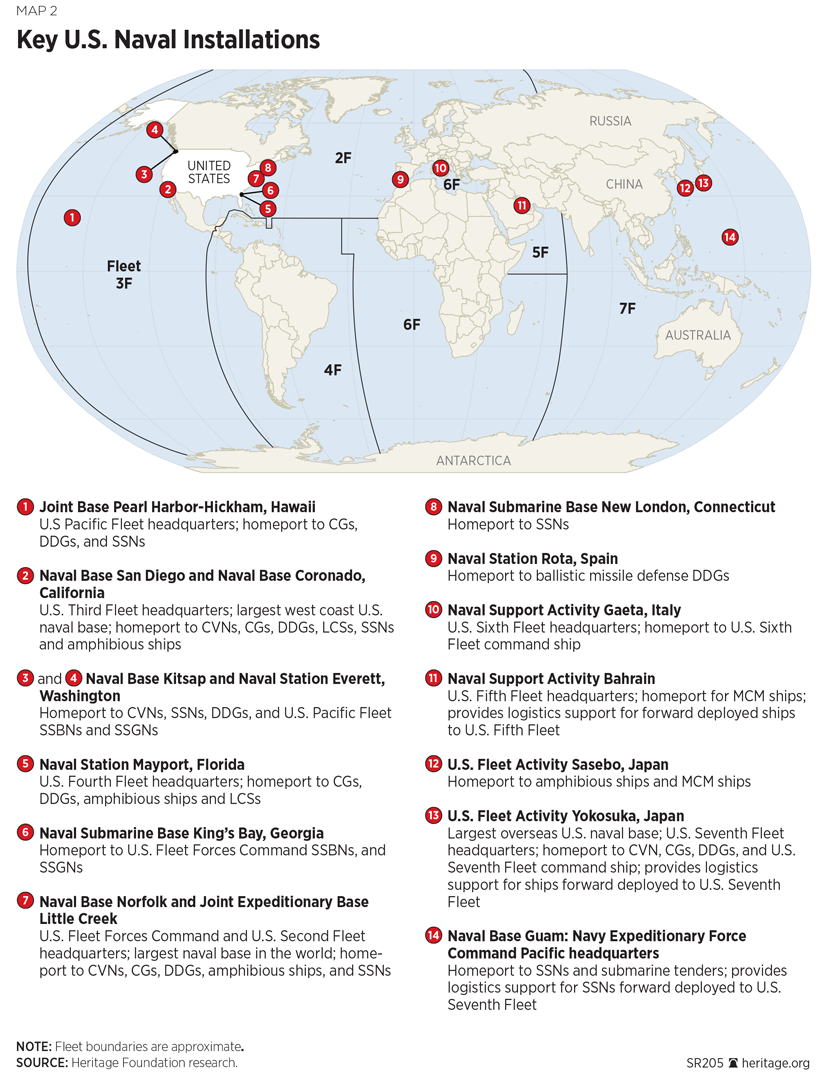
Homeporting ships overseas is not a panacea for meeting operational demands with a smaller fleet. The 2017 collisions of Japan-based destroyers and the resulting readiness reviews clearly showed what can occur when overseas-based ships are overcommitted and improperly maintained and their crews are not provided sufficient time to train. Because of modernization and depot maintenance requirements that cannot be conducted in foreign ports, ships homeported overseas can remain overseas for a maximum of only eight to 10 years. Additionally, without significant U.S. investment, the number of ships these ports can berth and maintain is limited.
There also are cultural and political barriers to forward basing certain types of warships in foreign ports, particularly nuclear-powered vessels such as submarines and aircraft carriers. Many partner nations have restrictions even on port visits by nuclear-powered vessels. Moreover, nuclear-powered vessels require additional special infrastructure for maintenance, and this further increases costs. Finally, increasing the concentration of U.S. naval forces based overseas also increases their vulnerability to attack from adversaries. The growing proliferation of long-range precision guided weapons makes fixed naval bases concomitantly harder to defend, especially from near-peer competitors.
The Navy can also increase deployed presence by forward stationing ships. These ships are homeported in CONUS, and each ship has two complete CONUS-based crews assigned to it. The ship can then remain on deployment while these crews rotate out to the ship, effectively doubling the normal deployment time without overstressing the crew. Littoral combat ships and nuclear guided missile submarines use this deployment model. Expanding this dual-crew model to other classes of ships, such as DDGs and SSNs, presents its own challenges. First, the doubling of manpower for each ship or submarine brings significant long-term costs, primarily from the additional manpower that must be recruited and retained.
There is also the challenge to ensure that the nondeployed crew is properly trained and remains proficient across a growing range of missions, because the nondeployed crew does not have an assigned ship on which to train. This would require additional training simulators or dedicating several ships and submarines of the same class just to training and certification of nondeployed crews. Although the current LCS model uses specific ships just for training nondeployed crews, this is not a cost-effective model and does not increase the operational availability for a given fleet size.
Finally, the higher operational tempo for these ships could cause them to reach the end of their effective service life sooner than planned. This is especially true for submarines and aircraft carriers whose reactor cores are programmed for a specific period based on a planned operational tempo. Significantly increasing their operational tempo would lead to unplanned reactor core refueling with significant unplanned cost that would divert funding from new ship acquisitions and operational deployments.
Both of these alternative deployment options require formal agreements and cooperation from friends and allies that permit the Navy to use their ports. They also require U.S. investment in additional support facilities abroad. As history has repeatedly shown, host nations can rescind these agreements for various reasons and close their ports to U.S. naval forces. A prime example is the Philippine government’s 1991 decision not to renew a long-standing Military Bases Agreement with the United States, thereby forcing the U.S. Navy to relocate its primary logistics hub in the Western Pacific. An overreliance on foreign ports that may not be available when needed could seriously limit the ability of the United States and the Navy to maintain a deployed presence and respond rapidly to maritime crises in the region served by the affected ports.
Any decision to increase the number of U.S. naval forces homeported or forward stationed overseas must weigh these advantages and disadvantages and be supported by adequate and stable long-term funding. Any operationally significant increase in overseas basing of naval forces would require several years to implement due to increased infrastructure and defensive systems and would be heavily influenced by host-nation agreements. It is important to remember that overseas homeporting or forward stationing ships helps to meet the Navy’s enduring forward presence requirement with a smaller fleet, but it does not reduce the number of ships and submarines required to fight and win two-MRCs concurrently or nearly so.
This analysis will not address the force structure that any hypothetical increase in overseas homeporting or forward stationing ships might require since there are no currently funded plans to do so and they do not reduce the fleet capacity required by the two-MRC construct. Finally, even with the Navy’s increased focus on increasing maintenance and training for FDNF ships, history has shown that it is much harder to enforce these goals for overseas homeported ships in the face of frequent emergent tasking. While some measured increases in overseas homeporting and forward stationing ships will provide small improvements in deployed underway days and the ability of the fleet to respond to crises more rapidly, a detailed analysis of all potential advantages and disadvantages must be conducted first.
13 Carrier Strike Groups
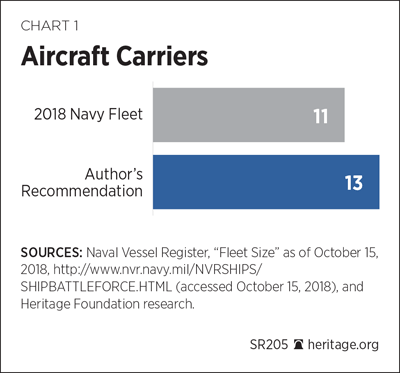
The goal for the Navy’s aircraft carrier fleet is derived from analysis of the Joint Force wartime planning scenarios and meets the GFMAP goal for continuous 2.0 CSG forward presence and 3.0 CSG 30-day surge deployment capacity. The U.S. Navy has deployed an average of six aircraft carriers to support major U.S. military operations since the end of the Cold War; key examples include combat operations in Kuwait in 1991,REF Afghanistan in 2001,REF and Iraq in 2003.REF As summarized by the Congressional Budget Office:
Maintaining a fleet of 11 carriers would usually allow 5 of them to be available within 30 days for a crisis or conflict (the rest would be undergoing scheduled maintenance or taking part in training exercises and would be unready for combat). Within 90 days, the Navy would generally have seven carriers available. A larger force would be able to provide more ships for a conflict, and a smaller force fewer.REF
This correlates with the recommendations of numerous force-sizing assessments, from the 1993 Bottom-Up Review (BUR)REF to the Navy’s 2016 Force Structure Assessment,REF each of which recommended at least 11 aircraft carriers. Current U.S. law requires the Navy to maintain a force of “not less than 11 operational aircraft carriers.”REF The Navy has stated that with its current fleet of 11 operational carriers, it cannot meet the requirement to maintain two carriers deployed at all times and three ready to surge deploy within 30 days.REF
Assuming that 11 aircraft carriers are required to engage simultaneously in two MRCs and that the Navy should ideally have a 20 percent strategic reserve both to avoid committing 100 percent of its CSGs and to account for scheduled maintenance, the Navy should maintain 13 CSGs. As part of these 13 CSGs, the Navy should maintain 13 operational carrier air wings.
The size and composition of the U.S. Navy’s CSGs has evolved over the past several decades with changes in the current fleet architecture, strike group missions, and the maritime threat environment. Decreasing fleet size and the retirement of several classes of ships, such as guided missile frigates (FFGs), also has affected the nominal strike group composition.
The November 2017 Chief of Naval Operations guidance on “Force Composition of Afloat Navy and Naval Groups” provides the most current description of CSG baseline capabilities and force mix:
- Five to seven air and missile defense–capable large surface combatant ships (guided missile cruisers or guided missile destroyers) to conduct anti-ship missile and anti-air warfare defense;
- A naval integrated fire control, counter air–capable cruiser as the preferred ship for the air and missile defense commander;
- No fewer than three cruise missile land attack–capable (such as Tomahawk land attack missile or follow-on weapon) large surface combatant ships;
- No fewer than three surface warfare cruise missile–capable (such as Harpoon or follow-on weapon) large surface combatant ships;
- No fewer than four multi-functional tactical towed array systems; and
- One fast combat support ship (T-AOE) or equivalent pair of dry cargo and ammunition (T-AKE) and fleet replenishment oiler (T-AO) combat logistics force ships.REF
Although not mentioned in this instruction, historically, at least one SSN was typically assigned to a CSG during the Cold War.REF
Based on these requirements and the capabilities of current and planned ship classes, the nominal CSG force composition to possess the capacity needed to support a major regional conflict is:
- One nuclear-powered aircraft carrier;
- One carrier air wing (CVW);
- One guided missile cruiser;
- Four guided missile destroyers;
- Two guided missile frigates;
- Two nuclear-powered attack submarines;
- One fast combat support ship or pair of one dry cargo and ammunition and one fleet replenishment oiler; and
- Until the Navy’s new FFG(X) becomes operational, a nominal CSG that consists of six instead of four DDGs.
15 Expeditionary Strike Groups
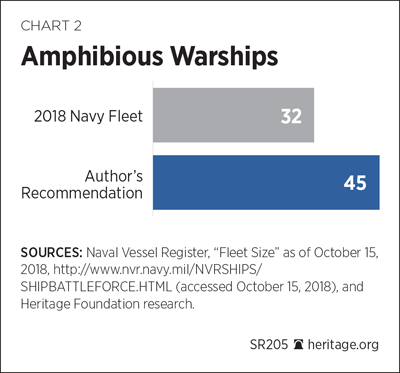
The 1993 Bottom-Up Review recommended a fleet of 41 large amphibious vessels to support the operations of 2.5 Marine Expeditionary Brigades (MEBs).REF Since then, the Marine Corps has said that it needs to perform two MEB-level operations simultaneously, which would require a fleet of 38 amphibious vessels.REF The number of amphibious vessels required in combat operations has declined since the Korean War, in which 34 amphibious vessels were employed. For example, 26 amphibious ships were deployed in Vietnam; 21 were deployed for the Persian Gulf War; and only seven supported Operation Iraqi Freedom, which did not require a large sea-based expeditionary force.REF The Persian Gulf War is the most pertinent example for a modern fleet analysis because it was a two-MEB operation, the capabilities of this 1991 amphibious force are similar to present-day amphibious ships, and the modern requirements for an MEB most closely resemble this engagement.REF
The Navy specifies the following requirements (among others) for an expeditionary strike group:
- “A minimum of three amphibious warships…dependent on the CCDR requirements and missions…and specific ship capacities and capabilities.”
- “At least one amphibious assault ship, multi- or general purpose ship (landing ship assault (LHA) or landing helicopter dock (LHD)).”
- “At least one amphibious transport dock ship (LPD).”
- “At least one amphibious dock landing ship (LSD).”REF
The Navy also specifies that for an ESG, “other forces [be] assigned (surface combatants and auxiliary support vessels will be similar to those assigned to a CSG dependent on the threat and capabilities of the ships assigned).”REF
According to the Marine Corps, an MEB consists of five LPDs, five LSDs, and five amphibious assault ships, comprised of a combination of LHAs and LHDs.REF In conjunction with the Navy’s Expeditionary Strike Group (ESG) definition, five ESGs compose one MEB AATF.REF Based on these requirements and definitions, the nominal ESG engaged in an MRC would include:
- One landing ship assault or landing helicopter dock,
- One amphibious transport dock,
- One amphibious dock landing ship,
- Two guided missile destroyers,
- Two guided missile frigates, and
- One fast combat support ship or pair of one dry cargo and ammunition and one fleet replenishment oiler.
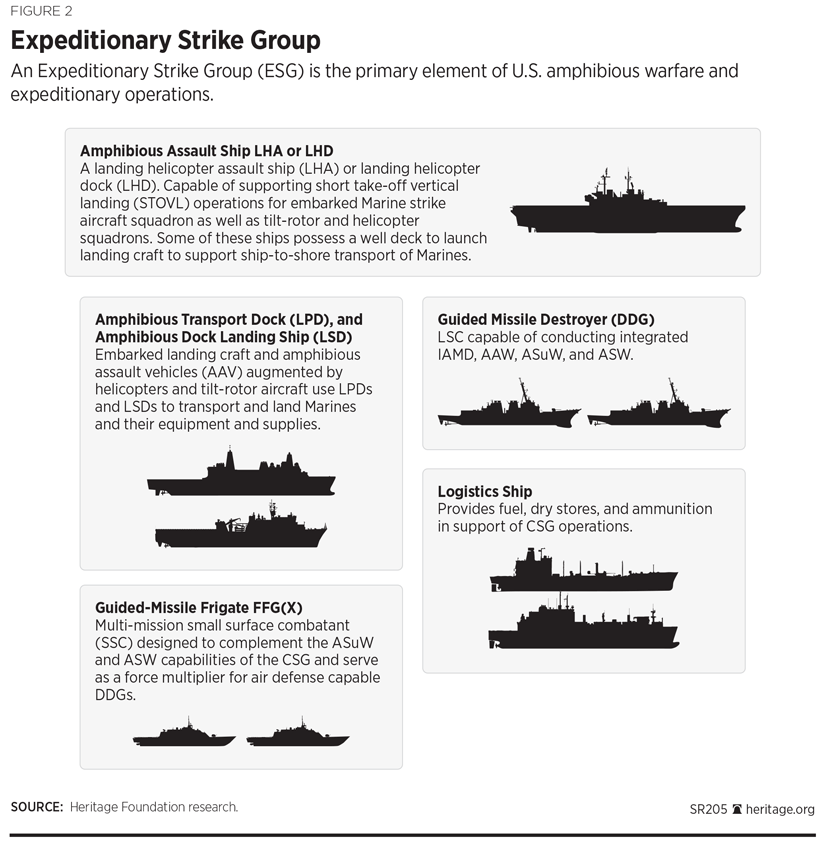
Two simultaneous MEB-level operations therefore require a minimum of 10 ESGs or 30 operational amphibious warships. The 1996 and 2001 Quadrennial Defense Reviews each recommended a force of 12 ARGs. While the Marine Corps has consistently advocated a fleet of 38 amphibious ships to execute its two-MEB strategy,REF it is more prudent to field a fleet of at least 45 amphibious ships. This incorporates a more conservative assumption that 12 ESGs could be required in a two-MRC scenario against near-peer adversaries while ensuring a strategic reserve of 20 percent, resulting in a force of 15 ESGs.
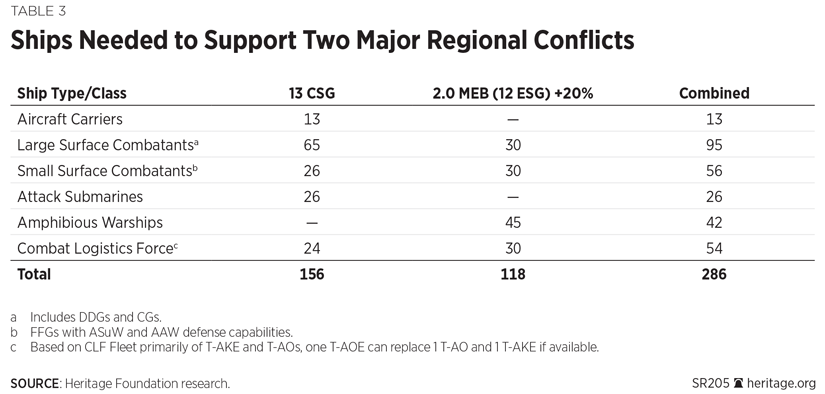
105 Large Surface Combatants
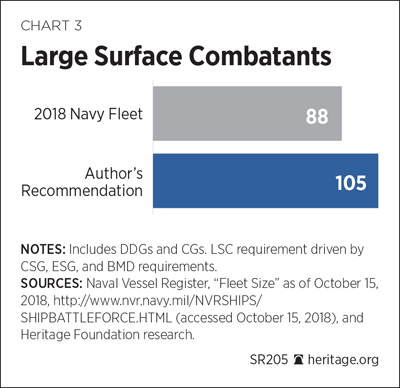
Large surface combatants are multi-mission surface warships capable of conducting anti-air warfare (AAW); anti-surface warfare (ASuW); anti-submarine warfare (ASW); strike warfare; and (for some platforms) ballistic missile defense. Guided missile cruisers and guided missile destroyers are classified as LSCs. In addition to supporting CSGs and ESGs, LSCs can also operate independently or as part of a surface action group (SAG), conducting one or more of these missions as well as providing persistent forward presence.REF
The CCDR demand for BMD-capable LSCs has grown consistently over the past several years as the ballistic missile threat to the U.S. and its treaty allies has grown. For example, a March 13, 2015, DOD information paper on the Navy’s “BMD Capable Ships Requirement” reflects that the “CCDR demand has increased from 44 in FY12–14 to 77 in FY16” and that “[t]he minimum requirement for 40 advanced capable BMD ships is based on the Navy unique requirement” of “27 to meet CVN escort demand for rotational deployment of the carrier strike groups,” “9 in FDNF Japan to meet operational timelines in PACOM,” and “4 in FDNF Europe for rotational deployment in EUCOM.”REF
Although the 2016 FSA did not provide a specific breakout of BMD contribution to the increased LSC requirement of 104 ships, it did state that the increase of 16 LSCs “deliver[s] increased air defense and expeditionary BMD capacity and provide[s] escorts for the additional Aircraft Carrier.”REF When deployed on a BMD mission, these ships are restricted to a specific geographic area in order to defend allies from likely BMD threat axes and would not normally be simultaneously assigned to a CSG or an ESG engaged in an MRC. Pursuit of additional shore-based Aegis BMD systems by the U.S. Navy and its Western Pacific and European allies would reduce the need to tether BMD-capable ships to specific maritime areas of responsibility (AORs).
The minimum LSC requirement of 105 ships is based on the following:
- LSC requirements for 13 CSGs and 15 ESGs in support of the two-MRC construct (Table 3): 95;
- BMD requirement for Indo-Pacific Command (INDOPACOM) and European Command (EUCOM): 13; and
- LSC contribution to the U.S. Navy’s enduring peacetime global forward presence requirement: 80.REF
71 Small Surface Combatants
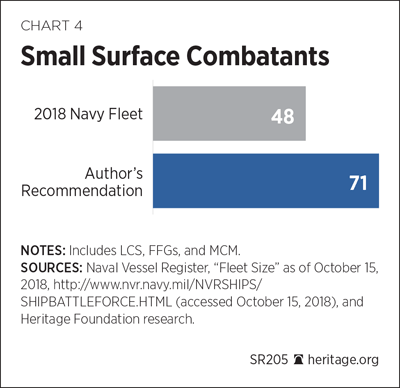
The Navy’s small surface combatant force consists of mine countermeasure ships (MCMs); littoral combat ships; and (by the mid-2020s) its new guided missile frigate.
In July 2017, the Navy released a request for information (RFI) to the shipbuilding industry with the goal of building a new class of 20 ships beginning in FY 2020, currently referred to as the future guided missile frigate (FFG(X)).REF The Navy stated that:
The purpose of this type of ship is to (1) fully support Combatant and Fleet Commanders during conflict by supplementing the fleet’s undersea and surface warfare capabilities, allow for independent operations in a contested environment, extend the fleet tactical grid, and host and control unmanned systems; and (2) relieve large surface combatants from stressing routine duties during operations other than war.REF
The RFI further specified that the FFG(X) will:
- “[N]ormally aggregate into strike groups and Large Surface Combatant led surface action groups but also possess the ability to robustly defend itself during conduct of independent operations while connected and contributing to the fleet tactical grid”;
- “Complement the surface warfare (SuW) capabilities of a Carrier Strike Group and Expeditionary Strike Group with capacity in aggregated operations (e.g., as a pack) to deter or defeat aggression by adversary warships with over-the-horizon anti-ship missiles”;
- “Perform anti-submarine warfare (ASW) scout and patrol missions that complement the capabilities of Strike Group and theater operations with enhanced active and passive undersea sensing capabilities”; and
- “Support transoceanic logistics movements by serving as a force multiplier to area air defense capable destroyers.”REF
The Navy’s 11 aging Avenger-class MCM ships provide its only current operational ship-based MCM capability. The Avenger MCMs and even future MCM-capable LCSs will operate in coordination with the MCM helicopters and UUVs to complete this mission. The Navy is developing and planning to procure 24 MCM mission modules for the LCS.REF According to the Assistant Secretary of the Navy for Research, Development, and Acquisition:
An overall total of 24 MCM mission modules are required to comply with Section 1046 of the FY 2018 NDAA which prohibits the retirement of legacy MCM forces until the Navy has identified replacement capability and procured a quantity of such systems to meet combatant MCM operational requirements that are currently being met by legacy forces.REF
Of the 32 planned LCSs, 12 will be outfitted with MCM mission modules to address the current fleet MCM demand. The LCS MCM mission module consists of mine detection and neutralization capabilities on SH-60 helicopters, UUVs, and USVs. It is also possible that these mission modules will be capable of deploying on other surface combatants in the future to increase MCM capacity.
The minimum SSC requirement of 71 ships is based on the following:
- FFGs required to support the 13 CSGs and 15 ESGs engaged in a two-MRC construct against a near-peer adversary (Table 3): 56;
- LCS MCM capacity requirement: 12; and
- FFG(X) requirement to assist DDGs in the defending transoceanic logistics ship movements: three dedicated, in addition to which at least one of the FFGs assigned to each CSG or ESG would assist in this mission.
54 Combat Logistics Force Ships
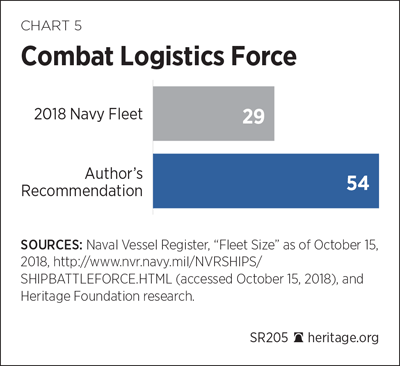
The Navy’s combat logistics force (CLF) provides fuel, dry stores like food and repair parts, and ammunition to CSGs, ESGs, and other naval groups, enabling them to remain deployed at sea for months at a time without having to enter port for critical logistics. The current CLF fleet consists of multiproduct fast combat support ships (T-AOEs); dry cargo and ammunition ships (T-AKEs); and fleet replenishment ships (T-AOs). (See Figure 2.)
The Navy currently has only two operational T-AOEs in the fleet. If the Navy continues with its current shipbuilding plan and just builds a CLF fleet of T-AOs and T-AKEs, each CSG and ESG will need one of each to meet the ammunition, dry-stores, and fuel requirements of these naval combatant groups. If the Navy were to establish a T-AOE replacement shipbuilding program as soon as possible, one T-AOE(X) could replace some of the combined T-AO and T-AKE pairs, thereby reducing the overall minimum CLF ship requirement. Even with an increased T-AOE force, the Navy should maintain excess T-AO and T-AKE logistics capacity to provide shuttle replenishment of T-AOEs in direct support of strike groups. If the Navy pursues increasingly distributed maritime operations, spreading the components of CSG, ESG, and even stand-alone surface action group operations, the requirement for CLF ships will increase to provide distributed logistics support.REF The minimum CLF requirement of 54 ships is driven by the logistics demand of 13 CSGs and 15 ESGs required for the two-MRC construct and current logistic ship construction programs. (See Table 3.)
77 Submarines
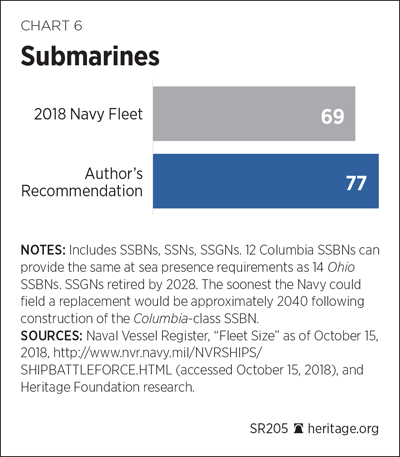
The U.S. Navy’s submarine force consists of nuclear ballistic missile submarines (SSBNs); nuclear guided missile submarines (SSGNs); and nuclear attack submarines (SSNs).
An SSBN’s sole mission is strategic nuclear deterrence, for which it carries long-range submarine-launched ballistic missiles. They provide the most survivable leg of America’s strategic nuclear deterrent force with 70 percent of the nation’s accountable nuclear warheads and its only assured second-strike or retaliatory nuclear strike capability.REF The Navy has a requirement to maintain 10 operational SSBNs to meet U.S. strategic nuclear deterrence requirements for SSBNs continuously at sea. It currently plans to build 12 Columbia-class SSBNs “to meet the requirement for 10 operational boats because the midlife overhauls of Columbia-class boats, which will not include a nuclear refueling, will require less time (about two years) than the midlife refueling overhauls of Ohio-class boats….”REF
In contrast, SSNs are multi-mission platforms whose primary peacetime and combat missions include covert intelligence collection, surveillance, ASW, ASuW, special operations forces insertion/extraction, land attack strikes, and offensive mine warfare.REF The Navy’s stated goal is to maintain at least 10 SSNs constantly deployed around the globe.REF Its 2016 FSA increased the SSN requirement from 48 to 66 submarines to “provide the global presence required to support national tasking and prompt warfighting support.”REF
The Navy currently operates four Ohio-class guided missile and special operations support submarines, all of which will be retired by 2028 with no planned replacements. Since these are converted SSBNs, they can carry up to 154 Tomahawk cruise missiles and can support special operations forces dry-dock shelter operations in their 24 large-diameter vertical launch tubes.REF Their retirement will result in the loss of 616 submarine-launched Tomahawk cruise missiles both from the fleet and from the Joint Force strike capacity.REF In comparison, current Virginia-class SSNs can carry a maximum of only 37 Tomahawk cruise missiles.REF
To help mitigate this drastic reduction in submarine cruise missile strike capacity, the Navy is adding a Virginia payload module (VPM) with four large-diameter tubes, which can carry 28 Tomahawk cruise missiles, to at least 20 new Virginia-class SSNs starting in FY 2019. Twenty-two VPM SSNs are needed to make up for the lost strike capacity of four SSGNs, and at least five constantly deployed VPM SSNs will be needed to provide the deployed strike capacity of one deployed SSGN. Combining the 10 SSN deployment requirement with the additional five deployed VPM SSNs equates to a steady-state deployed presence of 15.0 SSNs. Assuming that four SSNs are necessary to maintain one that is constantly deployed results in a force requirement of 60 SSNs just to meet the forward-deployed presence requirement.
Since the majority of U.S. submarine operations are classified, this analysis will not delve into these classified missions but will instead set an additional requirement for five SSNs in support of classified missions. SSNs can uniquely provide access against the advanced anti-access/area denial capabilities of near-peer competitors, which can threaten surface warships at considerable range. Two SSNs are therefore recommended for each CSG engaged in an MRC against a near-peer competitor (Table 3). Since these SSNs will focus on ASuW, land-attack strike, and other missions to help the Joint Force gain access in these denied/degraded areas, they will operate far from the main CSG. Deployed CSG SSNs will count toward deployed presence SSN goal.
SSGNs are not addressed in the recommended submarine force numbers because they will be retired by 2028, and the soonest the Navy could field a replacement would be approximately 2040 following construction of the Columbia-class SSBN.
The minimum requirement of 77 submarines is based on the following:
- Navy validated requirement for SSBNs: 12;
- SSN force to support steady-state 15 SSN forward-deployed presence goal: 60;
- SSN requirement to support the 13 CSGs in the two-MRC construct against a near-peer adversary (Table 3): 26; and
- Classified submarine mission support: 5.
Total Ship Requirement
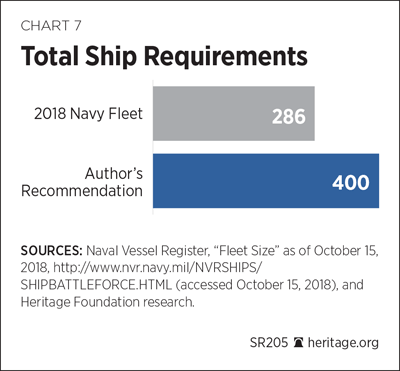
This report recommends a minimum of 400 U.S. Navy battle force ships (Table 4) to provide:
- The 13 CSGs and 15 ESGs required to meet the two-MRC construct;
- The historical steady state demand of approximately 100 ships constantly forward deployed in key regions around the world; and
- Sufficient capacity to properly maintain the Navy’s ships and ensure that its sailors are adequately trained to “fight tonight.”
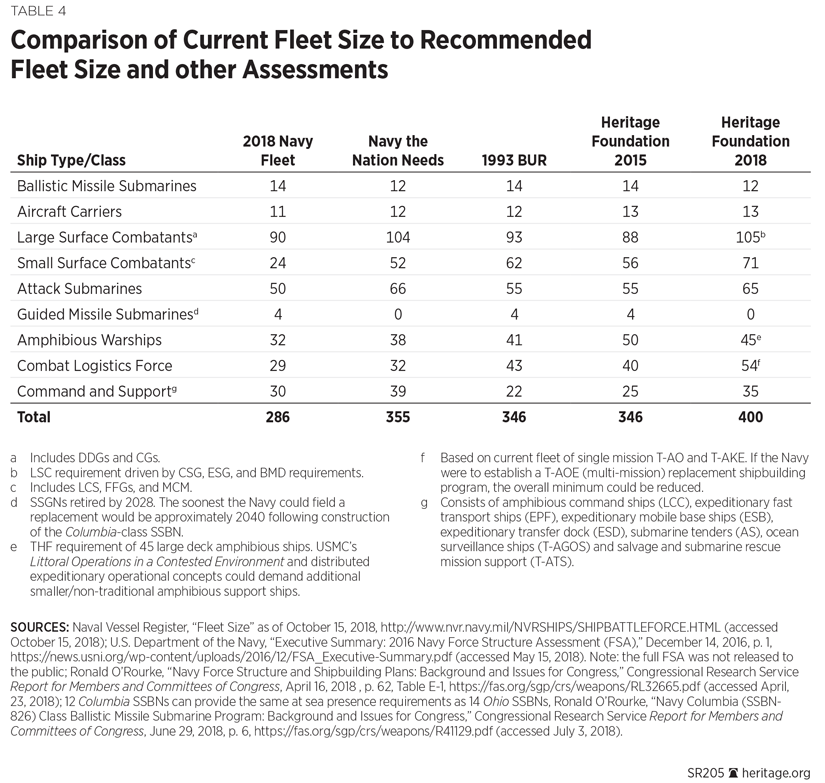
Because they have not yet matured sufficiently to replace manned ships or submarines in the battle force, unmanned systems are not included in the recommended fleet composition. Ship classes that are not current programs of record also were not included in this assessment because notional ship designs do not have validated requirements, their capabilities are unknown, and they have no assurance of being built.
Although a 400-ship fleet may be difficult to achieve based on current DOD fiscal constraints and the current capacity of the shipbuilding industrial base, this requirement is based strictly on assessed force sizing requirements. The Navy’s Annual Long-Range Plan for Construction of Naval Vessels for Fiscal Year 2019 shows that the U.S. shipbuilding industrial base has the capacity to build at least an additional 22 amphibious warships, 20 frigates, and 24 CLF ships between FY 2020 and FY 2039.REF This would be sufficient for the Navy to meet the recommended numbers of amphibious warships, SSCs, and combat logistics ships by FY 2039 (although the SSC mix would not yet include the 56 recommended frigates).
To achieve the 400-ship Navy goal by FY 2039 with the recommended force mix would require an additional $4 billion–$6 billion annually above the current long-range shipbuilding plan, which averages $25 billion from the mid-2020s to the mid-2030s.REF If Congress and the DOD fail to prioritize and provide stable funding for this long-term shipbuilding plan to achieve this requirement, our nation’s ability to deter aggression and win in conflict when necessary will be at risk.
—Thomas Callender is Senior Research Fellow for Defense Programs in the Center for National Defense, of the Kathryn and Shelby Cullom Davis Institute for National Security and Foreign Policy, at The Heritage Foundation. Before joining Heritage, he served for five years as Director for Capabilities in the Capabilities and Concepts Directorate of the Office of the Deputy Under Secretary of the Navy for Policy.
